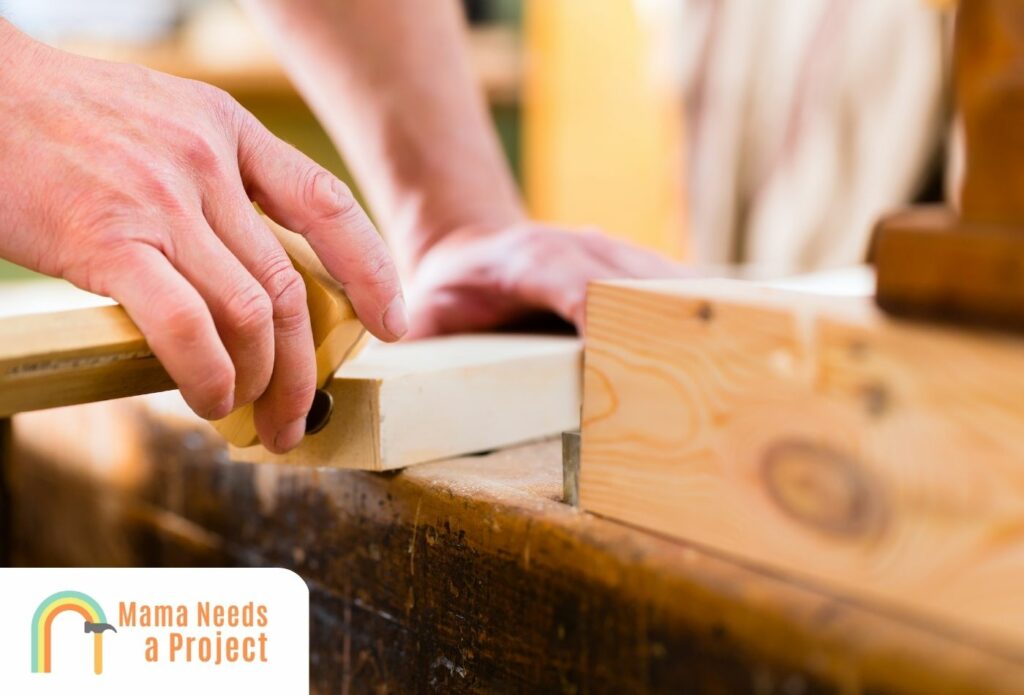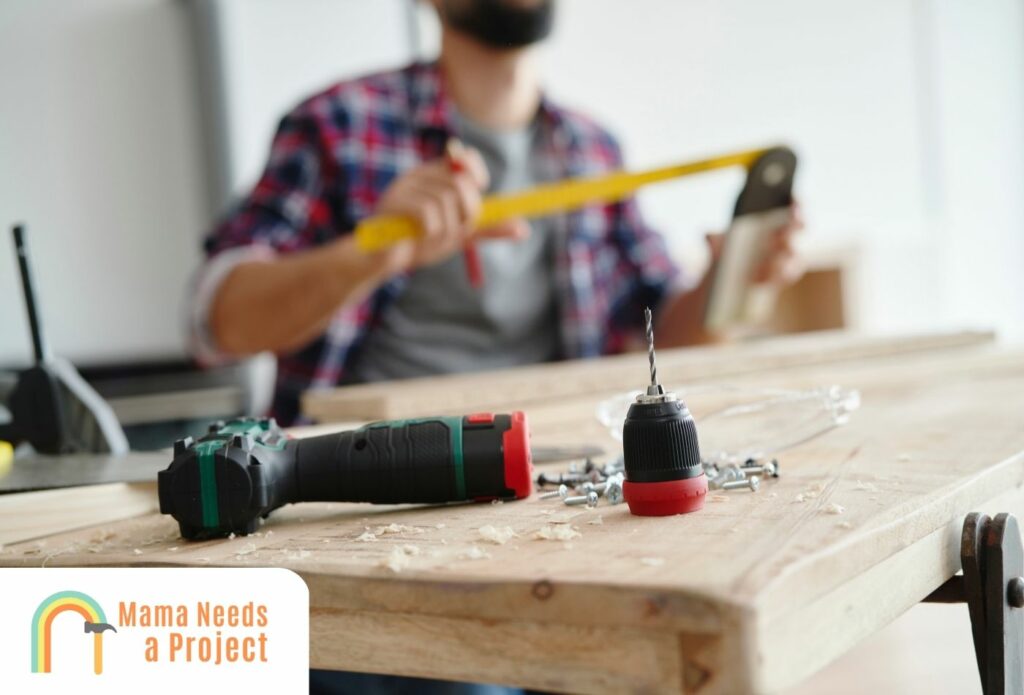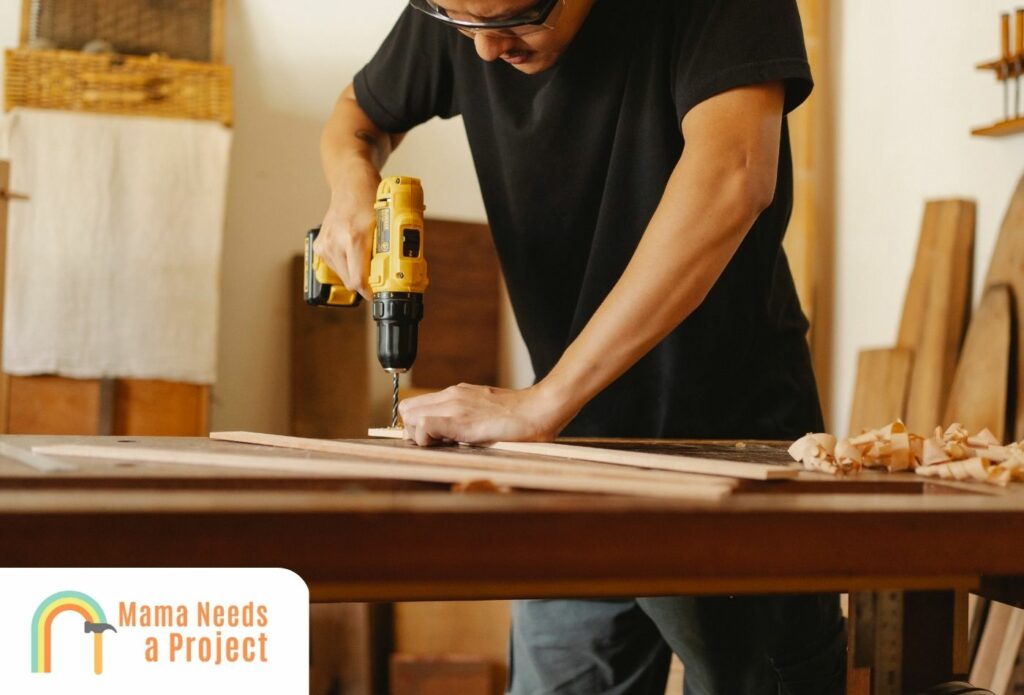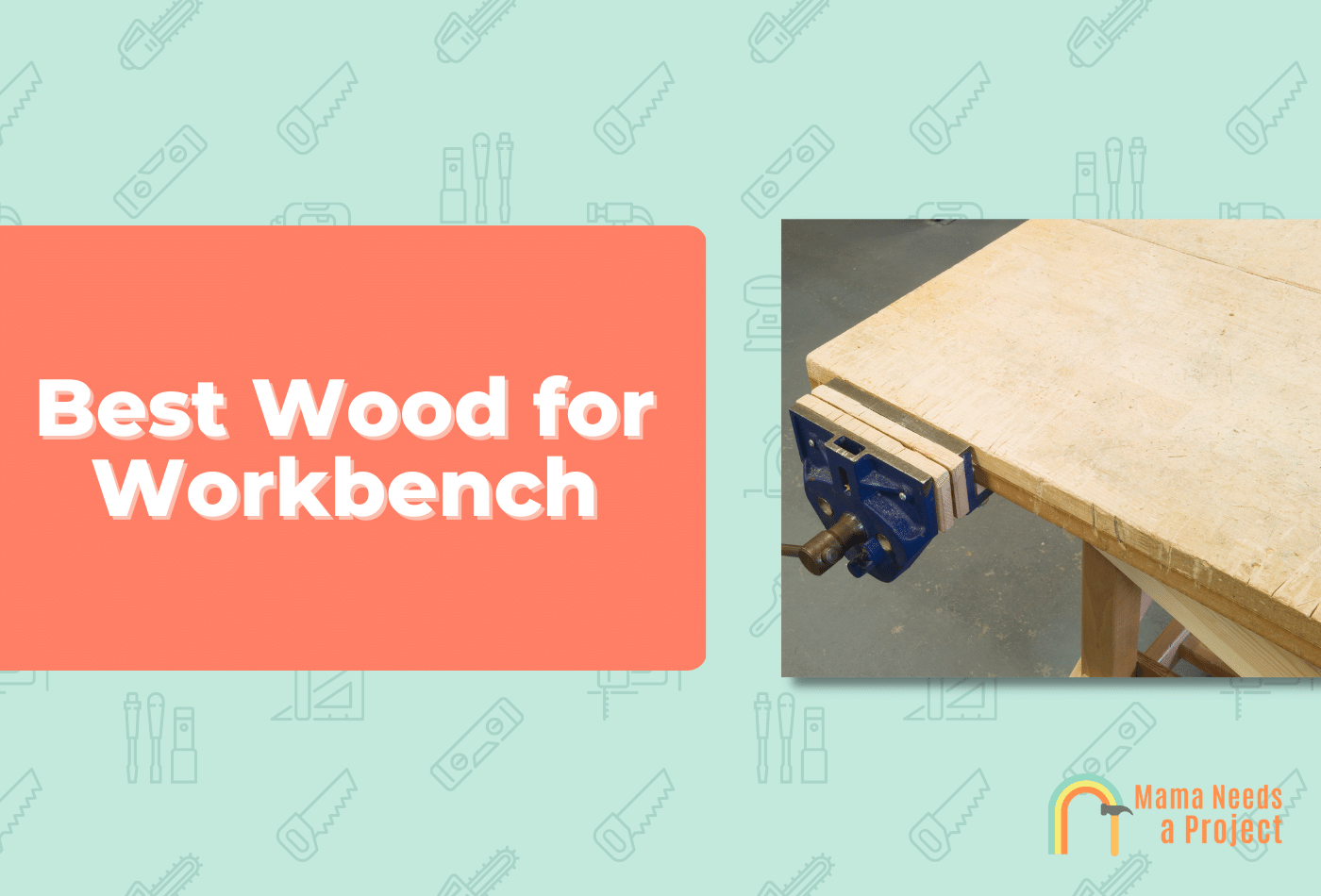Best Wood for Workbench (9+ Options in 2024)
A workbench is a woodworker’s best friend that gets used daily, which is why many people will spend years tweaking their workbenches so they’re just right.
So what’s the best wood for your wooden workbench top?
In this post, I’ll explain the best wood for your wood workbench that’s durable and long-lasting. There’s certainly no shortage of options, so finding the best wood can be a challenge.
- Hardwoods make better workbenches than softwoods because they’re heavier and more durable. Oak is one of the most popular and best woods for for a workbench top.
- Although softwoods aren’t as durable as hardwoods, a lot of woodworkers use them to make aesthetically pleasing workbenches. Softwoods are also more workable, which is important since workbenches are often highly customized.
Best Hard Wood Options for Workbench
Maple
If you’re looking for the best workbench wood, Maple is at the top of my list. Hard maple wood has everything you’re looking for in a bench top including durability and visual appeal. Plus, since it’s a wood that’s in abundance, it’s a more affordable option than other hardwoods.
So if your wood working projects involve a lot of hammering, sanding, sawing, etc., consider a maple workbench, as these resist scratches, gouges, dents, and dings better than other materials.
Maple’s durability also allows it to hold many power tools and other heavy items at once.
Lastly, if maple is stained and coated with polyurethane or another varnish, it’ll stay visually appealing for many years, provided it’s cleaned regularly and touched up every year or so.
In addition to your workbench, Maple is also one of the best wood for mallets.
Oak

Oak is another durable yet visually appealing hardwood, and because of these qualities it’s a very popular wood used for a workbench top.
The grain patterns that oak wood features are classic, and they go especially well in a rustic decor.
So if your average woodworking project involves heavy-duty tools, lots of banging and sawing, and corrosive chemicals sometimes, you can’t go wrong with oak.
Especially if this wood is reinforced by stain and polyurethane, you can expect it to hold up well for many years, provided it’s taken care of properly.
The heaviness of oak is another quality that makes it sought-after. Because it’s heavy, you don’t have to worry about it moving around as you work.
The two downsides of this material are its tendency to splinter and its price. The first issue can be avoided if you coat the material with varnish.
As far as price is concerned, there’s really no getting around the higher price oak commands. It’s more expensive than most hardwoods because it’s strong, classically beautiful, easy to maintain, and always in demand.
The two main kinds of oak are white and red oak.
Beech
Despite what their name implies, American beech trees grow throughout the world, particularly in Europe, North America, and Asia.
Beech wood is preferred by those who want their workbenches to be especially easy on the eyes.
This wood features unique grain patterns along with interesting textures, so it’s understandable why many woodworkers choose to leave their beech workbenches unfinished, i.e. they don’t apply poly or another varnish.
This material is pretty tough just like other hardwoods, and it can hold a pretty sizable weight.
Plus, it’s easy to work this material, so if you want to customize your workbench frequently—and many woodworkers do—consider beech.
Overall, it’s visually appealing, uniquely textured, easy to work, durable, and affordable.
Ash

Ash is another dense hardwood, but it’s one of the lighter varieties. It’s also smooth, and this is one of the reasons why it’s preferred.
Many consider ash to be between oak and beech in terms of its overall appeal and usefulness.
Although it’s a durable and dense wood, it’s not among the densest hardwoods, like hickory and black ironwood (African ironwood).
Therefore, it’s not one of the heaviest hardwoods, but it still doesn’t move around like a softwood would.
And while it is one of the more durable woods, it shouldn’t be used outdoors, as it doesn’t resist moisture all that well. Also, a range of insects can wreak havoc on it.
Lastly, it’s one of the more affordable hardwoods, especially if you keep it away from erosive elements and maintain it well over the years.
Birch
There are nine varieties of birch tree, including yellow birch, sweet birch, and white birch.
Yellow birch is the most-used of all the varieties, mainly because it’s visually appealing and affordable. Yellow birch is usually a shade of amber with brown streaks throughout.
If you don’t want your whole workbench to be made of birch, you can choose to have a birch veneer or benchtop plywood. There’s also birch fiberboard.
The reason why this solid wood isn’t preferred as a workbench material is because it’s coarse – which also makes it one of the best woods for desk tops.
Therefore, if your woodworking frequently requires a smooth benchtop, go with a different hardwood.
Birch is a durable hardwood, however, and it’s particularly moisture-resistant which means it can work well as a garage bench or carpenter’s bench.
Plus, wide fluctuations in temperature won’t wreak havoc on it.
That said, it is prone to bug infestations, and this is definitely something to consider if your workbench is going to be in a garage that’s apart from your home—these are more susceptible to insect infestations.
Best Softwood Options for Workbench
Pine
Pine is an attractive softwood, since it’s aesthetically pleasing and easy to work with. Therefore, if you need to construct a pretty complex workbench, it’s wise to consider pine; you can saw it easily and it takes nails well.
Most pine is yellow, white, or some variation of the two, and pine often features an appealing grain.
This material is also naturally rot-resistant, and if treated it becomes virtually rot-proof.
It’s not water-resistant though, so it’s prone to warping if overexposed to damp conditions.
Overall, however, it’s a durable softwood, and this is a main reason why it’s one of the most sought-after softwoods.
It resists scratches and dents well, which explains why it’s commonly used as flooring. And if coated with poly or another varnish, it’s especially durable.
Best of all, because it’s widely available, it’s not expensive.
So if you want to create a workbench that looks like it came right out of a centuries old farmhouse, consider pine!
Douglas Fir

Douglas fir is native to the western part of North America, which explains why it’s often called Oregon pine. But it grows in other parts of the world as well, particularly South America, Europe, and New Zealand.
Despite being a durable softwood, Douglas fir is pretty light. In fact, this is the reason why Douglas fir is often used to construct porches and similar outdoor structures that can benefit from having durability without the extreme weight.
And even though it’s lighter than other softwoods, it can bear a lot of weight, even more than some hardwoods. This is why Douglas fir is often used to make plywood and beams.
It resists moisture, decay, and insects pretty well, and its orange-red to reddish-brown color allows for seamless integration into a wide variety of decors.
Plus, it’s easy to alter. So if a highly customized workbench is what you’re after, Douglas fir won’t disappoint.
Cedar
Cedar is a naturally rot-resistant wood, which is why it’s been used to make decks, porches, and other outdoor structures for centuries.
Specifically, it holds up well against moisture, and insects have a hard time tearing it up.
Plus, it doesn’t need a lot of maintenance. It’s also an affordable wood, especially if it’s taken care of over the years.
Featuring a distinct pinkish-red color and sometimes streaks of purple, a workbench made of this material will not only be sturdy and reliable but also nice to look at.
Keep in mind, however, that cedar does lose a bit of its color as it gets older, eventually turning silver or gray.
If you’re going to be doing a lot of heavy-duty woodworking, consider using a hardwood instead of a softwood like cedar.
Sure, cedar is durable when compared to other softwoods, but it will get dinged and scratched routinely if you’re constantly sawing, hammering, and sanding, especially if there’s no polyurethane protecting it.
Redwood
While it’s certainly possible to build a workbench out of redwood, this isn’t done often since this wood is so expensive and not that durable.
However, if you want to create a workbench that’s aesthetically pleasing more than anything else, this is definitely a wood to consider.
While this wood doesn’t resist dents, scratches, and gouges well, it does hold up moderately well when exposed to moisture, and insects tend to leave this wood alone. It also resists fungi and other erosive elements.
Redwood boasts a rich, dark-red color, and it often features unique grain patterns.
If you want the redwood look but don’t want your workbench to be 100% redwood, get a wood veneer in this color. It’ll resemble the solid wood while there’s a hardwood or harder softwood underneath.
Alternative Wood Options for Workbench
Bamboo
Bamboo is a grass that’s more water-resistant than a lot of hardwoods, but it’s not 100% waterproof.
It’s more sustainable than most woods, since it grows faster.
Plus, bamboo is cheaper than most hardwoods and softwoods, and if taken care of it can prove to be quite cost-effective.
It can be greenish to light brown, and it boasts a unique texture.
It’s easy to work with, and that’s one thing that makes it attractive as a workbench material.
However, it isn’t all that durable when compared to maple, oak, cherry, etc., so it’s not the best option if your woodworking involves a lot of heavy power tools.
Like redwood, this is a good material for workbenches that are meant to be more aesthetically pleasing than useable.
Plywood
You can use plywood to construct a woodworking bench, since this material is durable and cheaper than natural woods.
One downside of plywood, however, is it’s less visually appealing, and it’s not going to last nearly as long as a solid wood workbench.
Plus, it can be on the coarse side if it isn’t high-grade plywood. High-grade plywood is smooth and visually appealing, and it’s moisture resistant. It can be insect-proofed too, and it’s heat resistant.
One thing to know about plywood is it’s engineered and made with chemicals, so if you have to cut this be sure to do so in a well-ventilated area wearing all necessary safety gear.
Medium-Density Fiberboard (MDF)
A woodworking bench could be constructed out of MDF, but this isn’t done often because MDF isn’t the strongest material.
However, you could use MDF as a veneer with a hardwood or softwood underneath.
Unlike a lot of hardwoods and softwoods, MDF rarely cracks, mainly because it’s extremely moisture-resistant.
But it’s definitely not something you’d see on a vanity bench, considering it’s not the most visually appealing wood alternative.
If you have a plywood workbench, it’s smart to include MDF, as these two materials go together and neither is too expensive.
Also, MDF has no wood grain because it’s engineered wood.
So if you want to avoid solid woods altogether, consider MDF and other non-wood materials that can be used to make a sturdy workbench.
Want to learn how to build your own workbench? Check out the video below!
Hardwood vs Softwood for Workbench Top
Durability
When it comes to durability, hardwoods have softwoods beat without a doubt.
Hardwoods are naturally denser, so they can resist scratches, dents, and gouges better than softwoods. Their denseness also helps them resist corrosive elements like chemicals and rain.
But this isn’t to say softwoods aren’t durable—of course they are! It’s just that hardwoods are considerably more durable.
Additionally, most hardwoods are moisture- and insect-resistant, which are important qualities for workbenches that are exposed to the elements regularly.
Some hardwoods, however, don’t resist moisture all that well. So if you’re in a place where the temperature fluctuates routinely, it’s best to go with either a hardwood or softwood that’s moisture resistant.
Visual Appeal
Visual appeal is another important factor to consider when choosing between hardwoods and softwoods.
Both wood types are visually appealing, but hardwoods are generally darker than softwoods.
Also, softwoods often have defined wood grain patterns, and they usually feature colorful streaks that make them unique.
Both softwoods and hardwoods can be stained, but one could argue that softwoods are better for this because they’re less dense, meaning the wood fibers are able to absorb more accentuating stain.
Especially if you want your workbench to go with the rest of your workshop’s decor, you’ll need a hardwood or softwood that matches its surroundings.
Cost
Cost is another thing that separates hardwoods and softwoods.
For the most part, hardwoods are more expensive than softwoods, but some softwoods—like redwood, for example—are more expensive than most hardwoods.
When it comes to hardwood, you can expect a higher price for a wood that’s extremely durable, like hickory.
When it comes to softwoods, you can expect higher prices from woods that are more visually appealing.
If both hardwoods and softwoods are too expensive for your workbench budget, this is when you should consider wood-based alternatives, like plywood and medium-density fiberboard (MDF). You can even use bamboo.
Workability
If you’re going to be making your own workbench, you should select a wood that’s workable. The best woods, in this sense, are softwoods.
Even if you just want a basic workbench, softwoods are the way to go, as you can always add on later.
This isn’t to say hardwoods aren’t workable; they are but their coarseness and hardness do make altering them more challenging.
So if you want to save time when making a workbench, opt for softwood over hardwood.
Maintenance
Hardwoods are easier to maintain than softwoods, in large part because they don’t get damaged as much. And if your bench isn’t getting damaged often, it won’t need maintenance more than once or twice a year.
Plus, with softwoods you have to be careful not to alter the appearance of the wood when cleaning it, but this isn’t as much of a concern with hardwoods since cleaning products rarely damage hardwoods.
Frequency of maintenance should be considered along with price. In other words, if a wood is more expensive but needs frequent maintenance, it’s probably best to avoid using this as a workbench material, since chances are you won’t get decent bang for your buck.
Factors to Consider When Choosing Wood for Workbench
Strength
Strength is one of the most important factors you should consider when selecting a wood for your workbench.
And remember: even if the wood you choose isn’t naturally durable, it can be made a lot stronger with a coating of polyurethane or another varnish.
If you’re going to be doing a lot of heavy-duty woodworking projects, it makes sense to go with a durable material.
Hardwoods, for example, are a lot sturdier than softwoods, meaning they’re built to last and able to remain functional even after they’ve been nicked and dinged here and there.
Weight
The weight of wood should also be considered.
If you use a wood that’s too thin, there’s a chance it won’t be sturdy when you’re working on it, which may prevent you from getting good results. With more weight comes more sturdiness and strength.
Cost
Cost should also be taken into account before you select the material you want for your workbench.
If you select a material that’s expensive but easily damaged, you’ll probably end up paying more for this material in the long run.
Therefore, it’s best to go with a more affordable material that lasts a long time; this way you get the most bang for your buck and never have to worry about the workbench quality being subpar.
Look
How the workbench looks is incredibly important too. Even if you use your workbench regularly, you should never let it look dirty or get untidy.
And to improve a workbench’s visual appeal, you can apply a finish, like clear varnish. This will accentuate the grain and color while considerable providing protection.
If you choose a material that’s naturally visually appealing, you won’t need to spend a lot of time cleaning or maintaining it, meaning you’ll be able to keep more money in your pockets.
Best Wood for Outdoor Workbench
Workbenches designed for outdoor use are usually made of solid wood, such as oak, maple, cherry, and walnut.
These reliable hardwoods can withstand the elements, including rain, wind, sunlight, and insects.
That said, even if you have a workbench designed for outdoor use, you shouldn’t leave it completely exposed to the elements. If you know it’s going to rain, for example, you should put a tarp over it.
And before temperatures drop and the snow starts to fall in the winter, take steps to protect your workbench.
Or, of course, you could just stick to having an indoor workbench so you avoid these hassles.
How Thick Should a Workbench Top Be?
Most workbench tops are 75 mm thick; this translates to about 3 inches. Your workbench top shouldn’t be thinner than 63mm or 2 1/2 inches.
If your workbench top is too thin, there’s a chance it will collapse because there’s too much weight on it. This is especially true if your workbench is made of a wood-based material, as these aren’t the strongest.
You can also check out this guide to finding the best workbench height.
Final Thoughts on Best Wood for Workbench
In the end, many woods and wood-based materials can be used to make a woodworking bench. Some popular options are: oak, maple, cedar, birch, Douglas fir, and beech.
When considering the best woods for your workbench, think about durability, workability, visual appeal, lifespan, and cost. After weighing all these factors they select the woods that are best for their needs and circumstances.
If durability is your main concern, go with a hardwood. If visual appeal is what you’re after, go with a softwood.
And if you really want to change things up, you can skip the wood altogether and go with a metal workbench.

